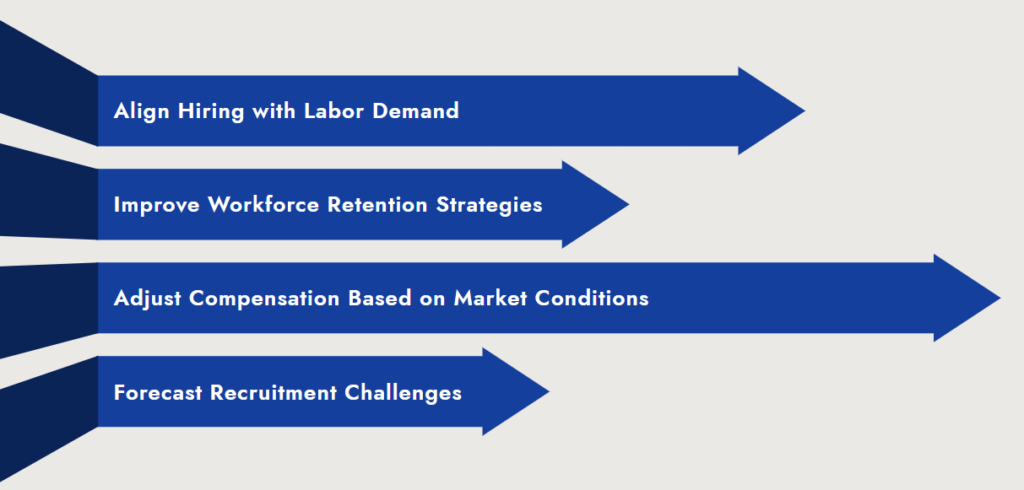The Job Openings and Labor Turnover Survey, JOLTS report is an important economic indicator that offers deep analysis into the United States employment system. Of the many reports that the Bureau of Labor Statistics publishes each month, this report tracks job openings, hiring, and the rate of turnover in the workforce. The JOLTS data allows economic analysts and investors to measure the strength of the labor market, detect changes in demand for the workforce, and make effective strategic decisions on recruitment.
In this article, we will take a look at the importance of the JOLTS report, its key features, as well as how businesses can use this information for strategic workforce planning and effective recruiting.

JOLTS Report: What Its Metrics Tell Us About Hiring Trends?
The Bureau of Labor Statistics publishes the JOLTS report each month as part of its effort to keep the public informed on the labor market in the United States. In the most recent report, there were 9.5 million open jobs and 6.2 million people hired, showcasing a continued demand for skilled workers. Moreover, the quits rate, as a measure of employee confidence, continues to be at a record high of 2.6%. Employees are confident in changing jobs which is a sign of economic and social wellbeing. It provides a comprehensive overview of job openings, recruitment, and terminations as well as streamlined information for businesses, policymakers, and investors to gauge the economy and the need for a workforce.
The critical metrics in the JOLTS report are:
- Job Openings: The vacancies which employers are actively trying to get filled.
- Hires: The count of workers recruited in a specified timeframe.
- Total Separations: Count of members of an organization who have left an organization either voluntarily or involuntarily.
- Quits Rate: The proportion of workforce in an organization that decides to leave the organization other than through layoffs, regarded as a measure of optimism in the labor market.
- Layoffs and Discharges: The rate of separations that happen without or against the will of the employee due to closing of the business, reduction of staff, and reorganization of the business.
Monitoring the above mentioned information helps an organization analyze and evaluate the trends of the labor market, and determines how to advance their recruitment methods.
The Role of JOLTS Data in Understanding Labor Market Trends
JOLTS data is widely used by economists, HR professionals, and business leaders to evaluate labor market conditions. According to a report from the Federal Reserve, sustained high job openings indicate a tight labor market, influencing wage growth and inflation. For example, in the past year, the quit rate in industries such as hospitality and retail surged by over 20%, signaling increased competition for workers. to analyze workforce trends and predict future labor market movements. Here’s how JOLTS job report data contributes to economic and hiring strategy:
1. Evaluating Job Market Health
The number of job openings and hires reflects overall economic activity. A surge in job openings indicates employer confidence and economic expansion, while a decline signals a slowdown or hiring freeze.
2. Understanding Industry-Specific Trends
JOLTS data breaks down labor market trends by industry, allowing organizations to assess workforce dynamics in sectors such as healthcare, technology, and manufacturing.
3. Measuring Workforce Stability
High quit rates suggest employees feel confident in finding new opportunities, whereas a rise in layoffs can indicate economic distress or shifting industry demands.
4. Predicting Future Employment Trends
By tracking job openings and separations over time, organizations can anticipate labor shortages, hiring surges, or downturns in specific industries.
How JOLTS Report Insights Drive Strategic Workforce Planning?

Organizations can use JOLTS data to refine their hiring strategies and stay ahead in competitive labor markets. Here’s how businesses can incorporate JOLTS insights into workforce planning:
1. Align Hiring with Labor Demand
By analyzing JOLTS job report data, businesses can identify industries with strong job growth and adjust their hiring plans accordingly. For example, if healthcare job openings rise significantly, HR teams should focus on sourcing healthcare talent proactively.
2. Improve Workforce Retention Strategies
A high quits rate suggests employees are actively seeking better opportunities. Organizations facing high turnover should review compensation packages, employee engagement initiatives, and career development programs to improve retention.
3. Adjust Compensation Based on Market Conditions
JOLTS data helps HR leaders benchmark salaries and benefits based on job market competition. If job openings remain high while hiring slows, employers may need to offer more competitive salaries to attract talent.
4. Forecast Recruitment Challenges
Tracking JOLTS data trends allows HR departments to predict hiring difficulties. Industries with labor shortages may require stronger employer branding, strategic outreach, and targeted talent acquisition efforts.
How JOLTS Report Data Reveals Labor Market Activity?
Investors and business strategists rely on JOLTS data to make informed economic decisions. The report serves as a real-time snapshot of employment trends, influencing:
- Federal Reserve Policies: Policymakers use JOLTS data to gauge inflationary pressures and labor market tightness.
- Corporate Investment Strategies: Businesses adjust hiring and expansion plans based on labor availability and workforce trends.
- Stock Market Performance: Analysts monitor labor market health to predict stock movements and industry growth trajectories.
Understanding how JOLTS job report insights impact business strategies helps organizations remain agile in fluctuating economic conditions.
How to Use JOLTS Data for Effective Workforce Planning?
JOLTS data helps in workforce planning through current information on hiring activity and churn rates. A study conducted by the National Bureau of Economic Research found that firms which JOLTS data for hiring purposes saw a 15% increase in workforce retention. Employers in healthcare, for instance, have used JOLTS trends to proactively staff during predicted vacancies which has resulted in an average decrease of 10 days in vacancy periods. This data can be leveraged by organizations to:

- Strengthen Talent Pipelines: By identifying skill shortages in growing industries, organizations can build talent pipelines through upskilling programs and proactive recruitment efforts.
- Optimize Recruitment Channels: Hiring trends from the JOLTS report help businesses assess the effectiveness of job boards, career fairs, and social recruiting campaigns.
- Enhance Workforce Flexibility: Companies facing high turnover can develop contingency hiring plans, including contract staffing and remote work models, to ensure business continuity.
How JOLTS Data Will Influence Hiring Strategies Moving Forward?
As labor market dynamics evolve, JOLTS data will continue to shape hiring strategies and workforce planning. Future trends include:
- AI-Driven Labor Market Analysis: Artificial intelligence and predictive analytics will enhance the use of JOLTS data, allowing businesses to forecast workforce needs with greater accuracy.
- Increased Use of Real-Time Employment Data: Organizations will integrate JOLTS data with internal HR metrics to gain a holistic view of hiring efficiency and employee retention.
- Industry-Specific Hiring Adjustments: Businesses will rely on granular JOLTS insights to tailor hiring strategies based on sector-specific workforce fluctuations.
- Policy-Driven Workforce Planning: Government labor policies will increasingly leverage JOLTS data to drive workforce training initiatives and job creation programs.
Conclusion
The JOLTS report serves as a vital component for understanding work market developments, hiring policies, and workforce management. By tapping into JOLTS data, businesses, economic experts, and investors are able to adapt to the dynamically changing labor market and improve their recruitment processes.Stay ahead in the labor market with actionable insights. Sign up on JobsPikr today to access real-time hiring trends and workforce analytics tailored to your industry.



